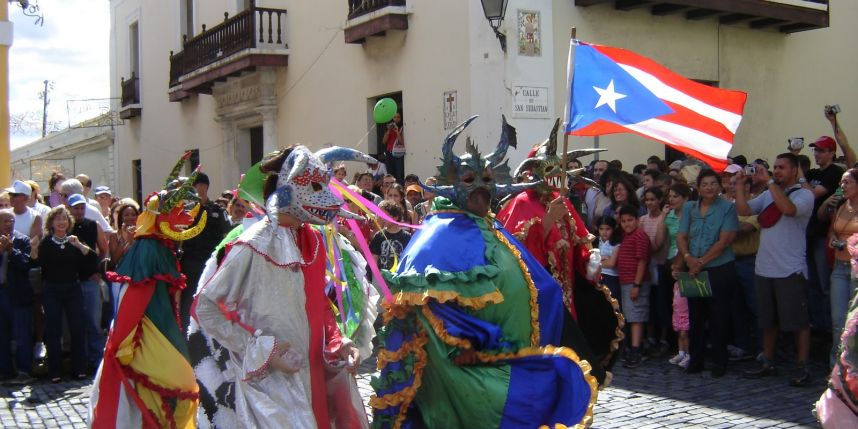Las Fiestas de San Sebastián
- Rafael Lopez de Azua

- Jul 14, 2016
- 3 min read

"The crowd looked like an overflowing river of heads, bobbing up and down in the torrent of humanity that was San Sebastián Street. The Fiestas de la Calle San Sebastián had nothing to envy New Orleans' Bourbon Street on Mardi Gras. Tens of thousands of night revelers crammed into the narrow cobbled street, barely able to move, framed by an unending row of fantastically colored colonial houses. The tremendous noise of the multitude, a jumble of voices, screams, laughter, curses, whistles, and music mixed with the strong sweet smell of beer and the heavier odor of sweat and urine, overwhelming the senses.
"From the second story balcony of his rented house, Angel San Miguel enjoyed an unfettered view of the grand celebration. This was mostly a youthful crowd, sprinkled with older people of young spirits. About fifty feet to his left, a group of celebrants had formed a small ring around two men who danced to the beat of a large conga bass drum, the rattle of a smaller military drum, and the shrill, off-tune notes of two trumpets." Justifiable Evil, Chapter I, page 1.

"Los Vegigantes", typically masked figures associated with carnivals in Puerto Rico, particularly in the towns of Ponce and Loíza, have also been incorporated into the San Sebastián Street celebrations.

Thousands upon thousands attend the San Sebastián Street Festival, held every year in January, in Old San Juan.

"A man in stilts, dressed like a red devil, had also joined the parade, and moved miraculously though the throngs of people as if wading in deep water." Justifiable Evil, Chapter I, page 4.
Most of the story in Justifiable Evil takes place during the Fiestas de la Calle de San Sebastián. In fact, the terrorists take advantage of the tumultuous occasion, renting one of the houses in that street in order to move unobserved through the crowds, knowing that the police will have its hands full with the throngs of people that attend it.
Celebrated at the end of the Christmas season, usually around mid January, the Fiestas attract hundreds of thousands of celebrants during the four days that it is held. Originally, the festival was founded in the 1950's by a priest who wanted to raise funds for the San José Church (the second oldest church in the Western Hemisphere), which borders a portion of San Sebastián Street. However, after the priest was transferred to another parish, his successor did not continue holding the yearly festivity. It was not until 1970 that the festival was revived. Since then, however, the Fiestas de la Calle de San Sebastián have become a permanent event in the old city, exponentially increasing the crowds of each year, which now spill into several of the nearby streets.

The festival has become so popular that it has spilled into the neighboring streets.
Countless stalls sell all sorts of locally made handicrafts, and the air is filled with the rich odor typical Puerto Rican food. Local celebrities give free concerts, and the rhythms of salsa, plena, merengue, reguetón, and bomba mix with the rattle of the drums and the tinkle of the xylophones of the marching bands of batuteras (baton twirlers) to create a discordant symphony of unending, joyous din.

"Los Cabezudos"

One distinctive feature of the Fiestas de la Calle de San Sebastián are the "Cabezudos"..." literally, 'the big-headed ones'--and they depict local characters who once lived, at one time or another, in Old San Juan. One of them seemed to be dressed like a general, his chest brimming with medals. A black woman wearing a red polka dot bandana around her hair and a slave's long dress of the same material chased him, while the general tried to avoid her." Justifiable Evil, Chapter I, page 2.
Other cabezudos represent characters from Puerto Rican stories, or even former politicians. (I actually knew the person on whom "the General" cabezudo was based. When I was a young boy, I used to see him hanging around the Plaza de Armas, in front of city hall, wearing a khaki cap and uniform, and several rows of medals. He performed a sort of service similar to that of a modern-day valet, parking cars, in exchange for a tip, for drivers who wanted to visit one of the local stores.)


The Fiestas de la Calle de San Sebastián provided the grand canvas on which the story of Justifiable Evil could be displayed. They reflect on a massive scale the joyous spirit and spontaneous rejoicing characteristic of most Puerto Ricans, when two or more of them gather together to celebrate.
(To be continued...)




























Comments